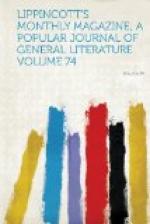In Machinery and Agricultural Halls, respectively, Great Britain has 37,125 and 18,745 feet; Germany, 10,757 and 4875; France, 10,139 and 15,574; Belgium, 9375 and 1851; Canada, 4300 and 10,094; Brazil, 4000 and 4657; Sweden, 3168 and 2603; Spain, 2248 and 5005; Russia, 1500 and 6785; Chili, 480 and 2493; Norway, 360 and 1590. Austria occupies 1536 feet in Mechanical Hall; and in that of Agriculture are the following additional allotments: Netherlands, 4276; Denmark, 836; Japan, 1665; Peru, 1632; Liberia, 1536; Siam, 1220; Portugal, 1020.
The foreign contributions in the department of machinery are, it will be seen, hardly so large as might have been anticipated. When the spacious annexes are added to the floor of the main hall, the great preponderance of home exhibitors—five to one in the latter—is shown to be still more marked. In Agricultural Hall the United States claim less than two-thirds. The unexpected interest taken in this branch by foreigners will enhance its prominence and value among the attractions of the exposition. The collection of tropical products for food and manufacturing is very complete. The development of the equatorial regions of the globe has barely commenced. Even our acquaintance with their natural resources remains but superficial. The country which takes the lead in utilizing them in its trade and manufactures will gain a great advantage over its fellows. England’s commercial supremacy never rested more largely on that foundation than now. Brazil, the great power of South—as the Union is of North—America, possesses nearly half of the accessible virgin territory of the tropics. Our interest joins hers in retaining this vast endowment as far as possible for the benefit of the Western World. A perception of this fact is shown in the exceptional efforts made by Brazil to be fully represented in all departments of the exposition, and in the visit to it of her chief magistrate, as we may properly term her emperor, the only embodiment of hereditary power and the monarchical principle in a country that enjoys—and has for the half century since its erection into an independent state maintained—free institutions.




